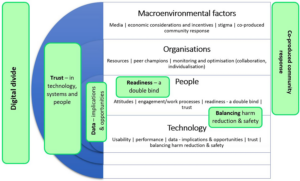Published in Harm Reduction Journal (2023)
Authors
Josh Dumbrell, Hadi Daneshvar, Alberto Oteo, Alexander Baldacchino, Catriona Matheson
Paper presented by Dr. Agnieszka Sulima and selected by the NIDA TDI Paper of the Month Committee
Publication Brief Description
The development of overdose alert and response technologies (ODART) that can detect overdose (OD) and alert first responders in a timely manner can be an effective way to reduce the number of drug-related deaths (DRDs). The available literature indicates that there is also a willingness to use these technologies by people who use drugs and affected communities.
Dumbrell at al. conducted a qualitative study using a focus group methodology to explore which factors are important for the acceptability of such technologies to people who use opioids (PWUO) in Scotland. The analysis uncovered several challenges faced by developers and implementation teams related to creating acceptable products that can feasibly support fatal OD prevention. Trust in technology, system and people were viewed as central to the acceptability of ODART and were closely linked to data security, privacy and confidentiality.
Furthermore, balancing harm reduction, safety and ambivalence was identified as an important factor that developers and implementation teams must consider for OD interventions to be acceptable to PWUO. Homelessness was negatively associated with willingness to use ODART posing a significant challenge for implementation as this is the most vulnerable group of people who use drugs and they are at high risk of OD. The authors concluded that effective ODART preventions will need to be sensitive to the complex relationship between technological, social/human, organizational and wider macroenvironment factors to maximize their use. Findings from this work can help to better understand areas for potential improvements and solutions to the challenges presented for ODART developers.
The acceptability of overdose alert and response technologies: introducing the TPOM-ODART framework Journal Article
In: Harm Reduct J, vol. 20, no. 1, pp. 40, 2023, ISSN: 1477-7517.

